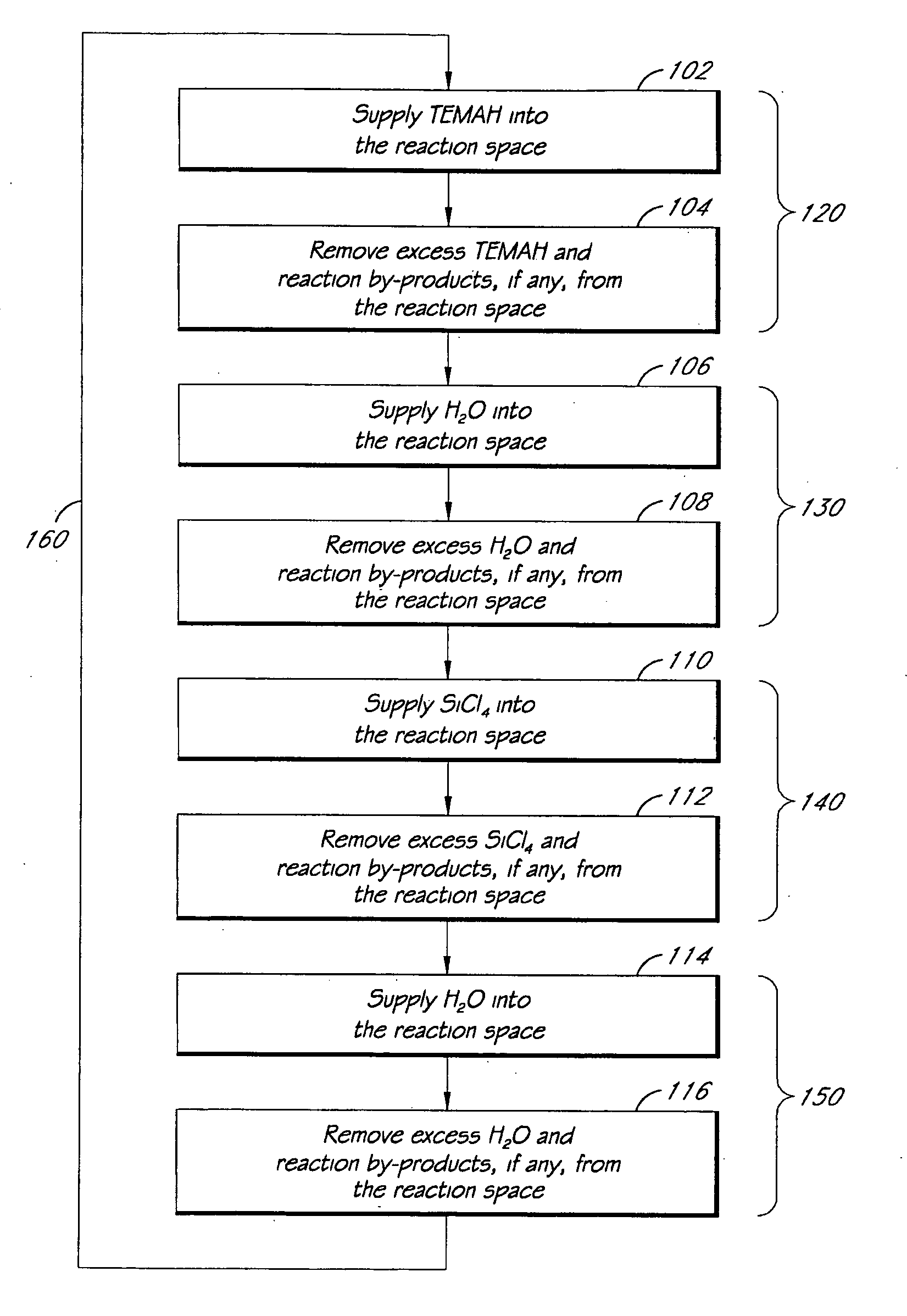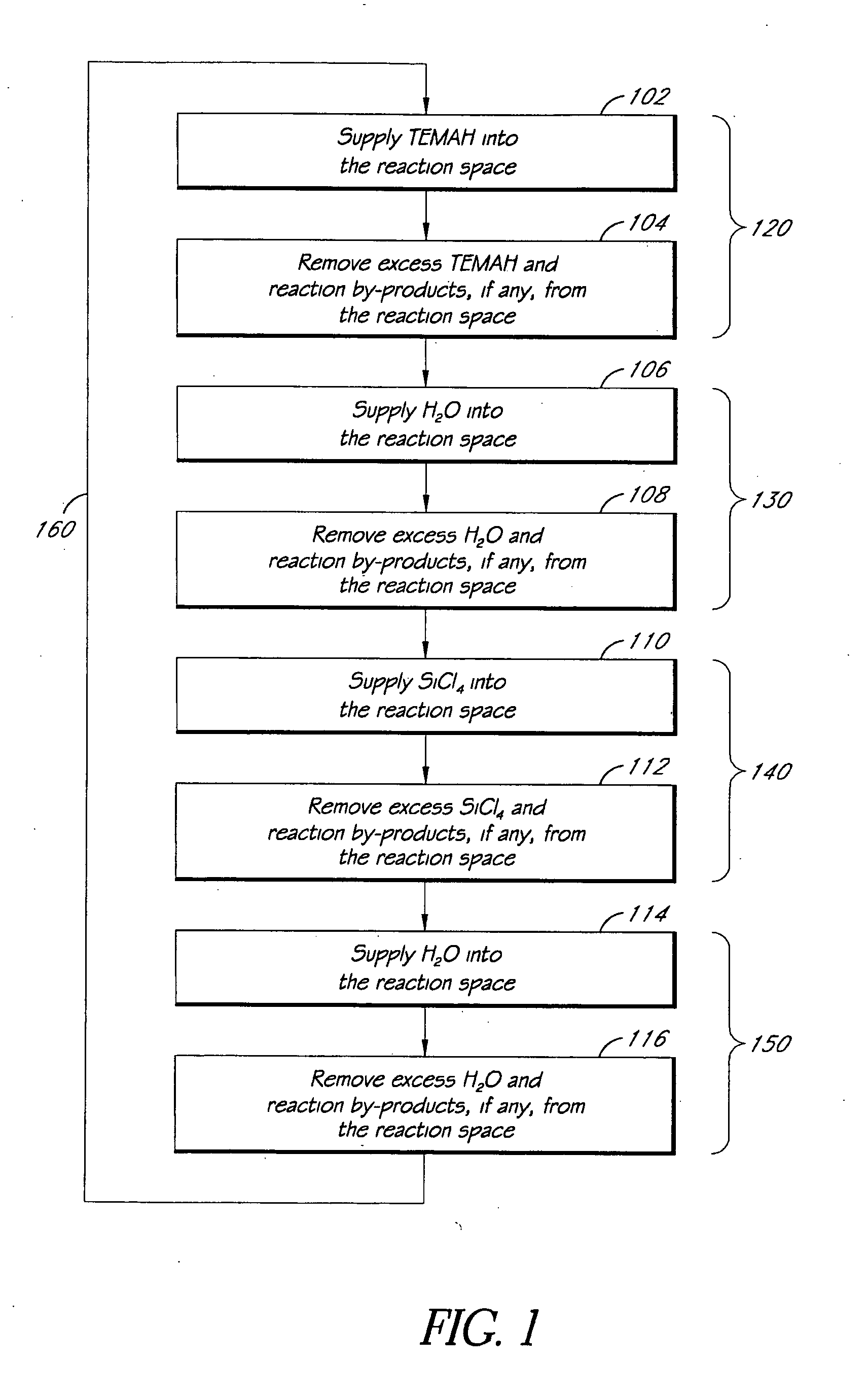ALD of metal silicate films
a metal silicate film and siosub>2 technology, applied in the field of metal silicate films, can solve the problems of unreliable thin film, adversely affecting device performance, and difficult to obtain traditional methods full film coverage on deep bottoms and vias
- Summary
- Abstract
- Description
- Claims
- Application Information
AI Technical Summary
Benefits of technology
Problems solved by technology
Method used
Image
Examples
example 1
[0080]A hafnium silicate film was deposited on a 300 mm silicon wafer using a Pulsar™ reactor manufactured by ASM America, Inc. The wafer included trenches with depth-to-width aspect ratios greater than about 50:1. Deposition was conducted at a substrate temperature in the range of about 250 to 320° C. The sequence processing steps included the following:
[0081](1) TEMAH pulse;
[0082](2) Ar purge;
[0083](3) H2O pulse;
[0084](4) Ar purge;
[0085](5) SiCl4 pulse;
[0086](6) Ar purge;
[0087](7) H2O pulse; and
[0088](8) Ar purge.
[0089]Steps (1)-(8) were repeated until a hafnium silicate film with a thickness of about 34 Å was formed on the silicon wafer. Uniform coverage was achieved within the trenches. A step coverage in excess of 95% was achieved. The film had a uniformity (1 sigma) of about 0.78%.
example 2
[0090]A hafnium silicate film was grown on a 300 mm silicon wafer at a wafer temperature of about 300° C. TEMAH was used as the metal reactant, SiCl4 was used as the silicon reactant and water was used as the oxidizing agent. The pulsing sequence was TEMAH / H2O / SiCl4 / H2O. The reaction space was purged with Ar between each of said pulses. Each cycle included a TEMAH / H2O pulsing sequence followed by five SiCl4 / H2O pulsing sequences (i.e., Hf / Si pulse ratio was 1:5). The growth rate of the hafnium silicate film was about 0.95 Å / cycle.
[0091]The hafnium silicate film formed had a hafnium concentration of about 18%, a silicon concentration of about 15% and an oxygen concentration of about 66%. Carbon and chlorine impurity levels were less than about 1% (i.e., 10,000 ppm) and 0.2% (i.e., 2000 ppm), respectively, as determined by nuclear reaction analysis (NRA) and rutherford backscattering spectrometry (RBS). The hafnium silicate film had a step coverage of about 100%.
[0092]In at least some...
PUM
| Property | Measurement | Unit |
|---|---|---|
| Temperature | aaaaa | aaaaa |
| Temperature | aaaaa | aaaaa |
| Temperature | aaaaa | aaaaa |
Abstract
Description
Claims
Application Information
 Login to View More
Login to View More - R&D
- Intellectual Property
- Life Sciences
- Materials
- Tech Scout
- Unparalleled Data Quality
- Higher Quality Content
- 60% Fewer Hallucinations
Browse by: Latest US Patents, China's latest patents, Technical Efficacy Thesaurus, Application Domain, Technology Topic, Popular Technical Reports.
© 2025 PatSnap. All rights reserved.Legal|Privacy policy|Modern Slavery Act Transparency Statement|Sitemap|About US| Contact US: help@patsnap.com


